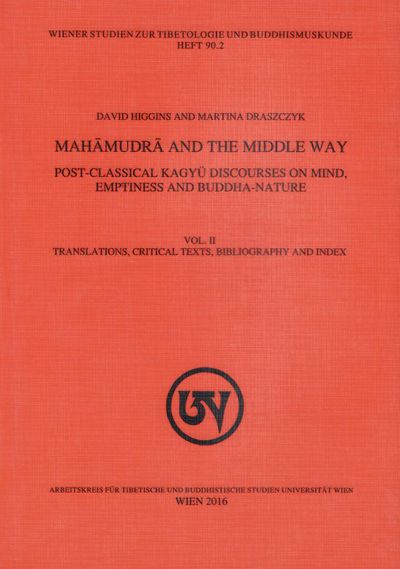Volume One
- Acknowledgement12
- Introduction14
- Current State of Research17
- Politico-Historical Background22
- Doctrinal Background25
- Navigating the Middle Ways29
- The Nature of Liberating Knowledge41
- Shākya mchog ldan44
- Shākya mchog ldan and the Bka’ brgyud Mahāmudrā Tradition45
- Life, Writings and Influences51
- Madhyamaka and the Dialectic of Emptiness: Rang stong and
Gzhan stong57- The Three Natures (trisvabhāva)65
- The Two Truths (satyadvaya)67
- Mahāmudrā and Buddha Nature74
- Direct Perception and Nondual Wisdom101
- The Great Seal in Shākya mchog ldan's Mahāmudrā trilogy109
- Mahāmudrā: What it is and What it is Not109
- Madhyamaka, Mantrayāna and Mahāmudrā116
- Mahāmudrā and What Remains (lhag ma : avaśiṣṭa)121
- The Problem of Cessation124
- Contested Methods of Realization127
- Responses to Sa skya Paṇḍita’s Criticism of Bka’ brgyud Mahāmudrā131
- Concluding Remarks145
- Karma phrin las148
- Overview149
- Life, Writings and Influences156
- Madhyamaka Approach159
- Extant Writings168
- Views of Reality169
- The Compatibility of Rang stong and Gzhan stong169
- The Two Types of Purity181
- Buddha Nature Endowed with Qualities184
- On the Unity of the Two Truths200
- "Thoughts are Dharmakāya"210
- Understanding Coemergence: the Inseparability of Saṃsāra and
Nirvāṇa217
- Concluding Remarks223
- Karma pa Mi bskyod rdo rje226
- Overview227
- The Differentiation and Identification Models229
- Reconciling Affirmation and Negation238
- Life, Writings and Influences242
- Blending Mahāmudrā and Madhyamaka250
- Emptiness and Hermeneutics of the Three Turnings253
- Core Soteriological Ideas and the Role of Philosophical Distinctions265
- Buddha Nature269
- Nature of Reality275
- Nature of Mind277
- The Problem of the Remainder (lhag ma : avaśiṣṭa)299
- On the Prospect of a Groundless Ground314
- On Whether or Not a Buddha has Wisdom320
- Mahāmudrā as Mental Nonengagement (amanasikāra)325
- Concluding Remarks341
- Padma dkar po342
- Overview343
- Life, Writings and Influences347
- The Basic Framework: Mahāmudrā and the Unity of the Two Truths350
- Emptiness and the Hermeneutics of the Three Turnings352
- Hermeneutics of Mahāmudrā as Ground and Path356
- The Two Faces of Mahāmudrā: the Modes of Abiding and Error357
- Mahāmudrā as the Mode of Abiding (gnas lugs phyag chen)359
- Mahāmudrā in the Mode of Error ( 'khrul lugs phyag chen)363
- Yang dgon pa on the Two Modes of Mahāmudrā369
- Padma dkar po's Transposition of Yang dgon pa's Distinction376
- Interpretations of the Mahāmudrā Distinction378
- Mahāmudrā and the Unity of the Two Truths382
- Asymmetrical Unity and Rival Truth Theories (Jo nang and Dge lugs)385
- The Ground of Truth393
- Path Mahāmudrā and Liberating Knowledge398
- Nonconceptual Knowing in the Shadow of the Bsam yas Debate399
- Three Strands of Amanasikāra Interpretation in Indian Buddhism403
- Padma dkar po's Three Grammatical Interpretations of Amanasikāra413
- Responding to Criticisms of Amanasikāra422
- Concluding Remarks426
- Final Reflections429
Volume Two
- Shākya mchog ldan10
- Introduction: the Mahāmudrā Trilogy11
- 1a. English Translation of Gzhan blo'i dregs pa nyams byed14
- 1b. Critical Edition of Gzhan blo'i dregs pa nyam byed26
- 2a. English Translation of Grub pa mchog gi dgongs pa rnam nges34
- 2b. Critical Edition of Grub pa mchog gi dgongs pa rnam nges43
- 3a. English Translation of Zung 'jug gi gru chen48
- 3b. Critical Edition of Zung 'jug gi gru chen71
- Karma phrin las pa86
- Perspectives on Rang stong and Gzhan stong87
- 1a. English Translation of Dri lan yid kyi mun sel88
- 1b. Critical Edition of Dri lan yid kyi mun sel91
- A Mystical Song of the View Proclaiming the Mode of Being94
- 2a. English Translation of the Yin lugs sgrog pa lta ba'i mgur95
- 2b. Critical Edition of the Yin lugs sgrog pa lta ba'i mgur98
- A Vajra Song100
- 3a. English Translation of the Rdo rje mgur100
- 3b. Critical Edition of the Rdo rje mgur102
- Karma pa Mi bskyod rdo rje104
- Critique of 'Gos Lo tsd ba' s Separation of Buddhahood and Buddha Nature105
- 1a. English Translation of Rgan po'i rlung sman (excerpt)105
- 1b. Critical Edition of Rgan po'i rlung sman (excerpt)109
- Some Criticisms of Shākya mchog ldan's Buddha Nature Epistemology111
- 2a. English Translation of Rgan po'i rlung sman (excerpt)112
- 2b. Critical Edition of Rgan po'i rlung sman (excerpt)115
- Two Minds in One Person? A Reply to the Queries of Bla ma khams pa117
- 3a. English Translation of Bla ma khams pa'i dris lan mi gcig sems gnyis118
- 3b. Critical Edition of Bla ma khams pa'i dris lan mi gcig sems gnyis120
- A Trove Containing Myriad Treasures of Profound Mahāmudrā122
- 4a. English Translation of Zab mo phyag chen gyi mdzod sna tshogs 'dus
pa'i gter123 - 4b. Critical Edition of Zab mo phyag chen gyi mdzod sna tshogs 'dus pa'i
gter134
- 4a. English Translation of Zab mo phyag chen gyi mdzod sna tshogs 'dus
- Mental Nonengagement as Unconditioned Mental Engagement143
- 5a. English Translation of Sku gsum ngo sprod rnam bshad (excerpt)144
- 5b. Critical Edition of Sku gsum ngo sprod rnam bshad (excerpt)147
- Amanasikāra, Emptiness, and the Tradition of Heshang Moheyan150
- 6a. English Translation of Dgongs gcig 'grel pa VI (excerpt)151
- 6b. Critical Edition of Dgongs gcig 'grel pa VI (excerpt)153
- Padma dkar po156
- Distinguishing Gnas lugs phyag chen and 'Khrul lugs phyag chen157
- 1a. English Translation of Phyag chen rgyal ba'i gan mdzod (excerpt)157
- 1b. Critical Edition of Phyag chen rgyal ba'i gan mdzod (excerpt)168
- Three Grammatical Interpretations of Amanasikāra175
- 2b. Critical Edition of Phyag chen rgyal ba'i gan mdzod (excerpt)176
- Refuting Sa paṇ's Equation of Mahāmudrā with Heshang's Chan Meditation179
- 3a. English Translation of Klan ka gzhom pa'i gtam (excerpt)180
- 3b. Critical Edition of Klan ka gzhom pa'i gtam (excerpt)188
- Response to Nam mkha' rgyal mtshan's critique of Padma dkar po's
Amanasikāra194- 4a. English Translation of Shar rtse zhal snga'i brgal lan (excerpt)195
- 4b. Critical Edition of Shar rtse zhal snga'i brgal lan (excerpt)197
- Amanasikāra in the Context of Nonreferential Meditation199
- 5a. English Translation of Snying po don gyi man ngag (excerpt)199
- 5b. Critical Edition of Snying po don gyi man ngag (excerpt)201
- Bibliography202
- Abbreviations of Canonical Collections, Journals, and Online Sources202
- Primary Sources: Indian Works202
- Primary Sources: Tibetan Works207
- Secondary Sources218
- Index232



